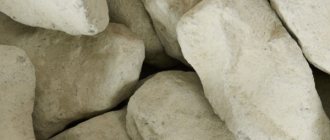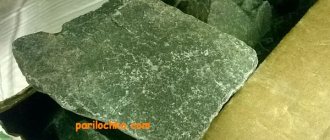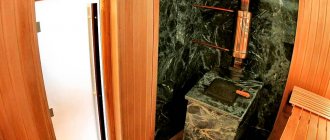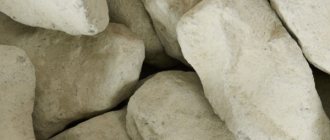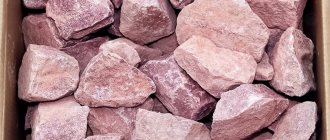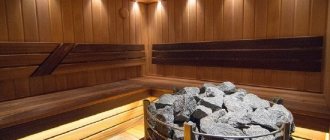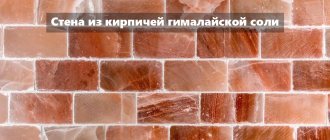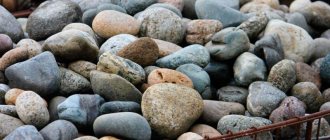Of the fairly extensive list of minerals used in the bath, soapstone is used most often, especially for lining various surfaces. The reason for its popularity is the relatively low price, easy processing and performance characteristics of the stone. Soapstone is a metamorphic rock widely used in bathhouses.
This stone has a thermal spectrum identical to the sun's rays. Therefore, the heat from it is perceived by a person most comfortably, and the steam created by the mineral is felt like a gentle, velvety touch.
5/5 — (1 vote)
Characteristics and properties
Soapstone is a rock complex in structure, consisting of talc (40-50%), magnesite (40-50%) and chlorite (5-8%). The mineral and chemical composition of the stone is variable. The ratios of chlorite and magnesite can vary, dividing the other half. The range is from 40 to 8 percent to 18 to 30%. At the same time, the general properties of the mineral from such different ratios of components practically do not change.
The color of soapstone is gray, depending on the impurities with white, brown, green or yellow tints, and much less often - red or dark cherry. The structure of the stone is opaque. The surface is silky, with a matte shine. Rock hardness is from 1 to 5.5. Density - approximately 2.75.
The mechanical properties of soapstone include softness. This quality allows stone to be processed into tiles with a torn surface and other building materials. Softness contributes to the gradual destruction of the mineral due to crumbling of talc at high temperatures.
Physical properties include:
- thermal conductivity - 3.3 W;
- specific heat capacity 0.98 kJ/(kg × K);
- hardness on the Mohs scale – 2.0–3.0.
Suitable for many things ️
Just like thousands of years ago, modest stones are important for a person’s comfortable life.
The use of the rock in the ceramic and food industries is due to the amazing properties of the rock.
Radio and electrical engineering uses soapstone as an insulating material.
Dense varieties are used in stone cutting.
For home, for family
Soapstone is also used in cosmetics. Every mother bought powder for her baby. Both now and hundreds of years ago, the base in them is talc.
Soapstone stoves retain heat for a long time. In a private house with such a stove you will not freeze in the most severe winter. Everyone will love a warm soapstone fireplace.
And for a bathhouse, facing with soapstone is ideal. It will keep warm for a long time and will not crack due to sudden temperature changes. And a bonus - the cladding absorbs sound well.
Soapstone also helps lovers of strong alcohol. You can buy such a lover a set of soapstone stones for whiskey as a gift. The stones are cooled in the freezer and placed in glasses (wine glasses, glasses, glasses) with the drink.
Absolutely harmless, perfectly cools any liquid (whisky, vodka, juice, lemonade). If you want to keep your drink hot, warm the stone; it will retain heat for a long time.
Paleolithic Venuses and elegant figurines of ancient Egypt were also cut from soapstone.
Pot stone makes excellent tableware. It holds heat wonderfully. Cook cabbage soup in such a pan, and you will not be able to distinguish it from the famous Russian daily cabbage soup.
The fashion for sinks and countertops came from the West. They have long appreciated the benefits of stone surfaces in the kitchen.
For the soul, stone cutters offer candlesticks, aroma lamps, lamps, boxes, funny figurines, and smoking pipes.
Where is the stone mined?
The leader in the production of soapstone chlorite is Finland. Russia takes second place in terms of supply volumes of this breed.
The largest deposit in our country stretches in a mountain range from Medvezhyegorsk to Finland itself. Mining is also carried out in the Shabrovskoye field in the Urals.
The stone is also mined in the following countries:
- Brazil;
- USA;
- India.
Magic: contact with the astral plane
Sorcerers from the Maghreb to Arabia used potstone amulets to protect against astral attacks. Pebbles also facilitate communication with the astral world, which is useful for sorcerers, magicians and other fighters of the esoteric front.
The magic of inconspicuous stones is suitable for improving logical thinking (Chinese healers are sure of this). Esotericists advise people of mental work to place a craft made of wax stone on their desktop.
Practical residents of northern countries wore amulets made from wen to protect against the evil eye and to protect against colds.
Interesting: some esotericists believe that stones “emit vibrations,” like the brain of a thinking being.
Areas of application
Due to the increased heat capacity and characteristics of the rock, the stone has been used since ancient times for the manufacture of carved products, in construction and in baths. Figures and figurines, vases, and dishes were created from soapstone. Pots and pans are still made from soapstone today.
Such dishes retain heat perfectly, leaving the dish hot for a long time. The earliest stone products found by archaeologists are 4–5 thousand years old.
In construction, stone is used as bricks, tiles, crushed stone, and powder. The materials are used for masonry, cladding walls of residential premises, swimming pools, and heated floors.
The mineral is excellent for masonry and cladding of fireplaces and stoves. Rock powder is added to building mixtures and concrete.
Impact on the body
The fiery mineral has a positive effect on the human body:
- helps in the fight against colds and viral diseases, strengthening the immune system;
- increases concentration and attentiveness;
- lowers high blood pressure in patients with hypertension;
- its warmth helps mitigate the effects of osteochondrosis and radiculitis.
There is an opinion that soapstone helps strengthen the musculoskeletal system due to the release of vitamin D from the firestone. This hypothesis has not been scientifically proven.
Features of use in the bath
Soapstone is widely used in baths and saunas because it holds heat well and slowly releases heat due to the hydroxyl group in the composition, as well as the poor heat conductivity of talc:
- Stone stoves are made from the rock or brick and metal stoves are lined with it. This means that there is a steel or cast iron firebox inside, which is covered on the outside with a stone casing. Lining the steel walls with soapstone tiles provides a comfortable level of heat dissipation. As a result, the sauna stove turns out to be quite economical, because the heat does not escape into the chimney with the products of burning wood, and at the same time it is powerful, but not scalding.
- The walls of the baths are sometimes finished with soapstone tiles, smooth or in the form of torn stones, for the aesthetics of the room. In an array, such cladding strongly resembles marble. This finish also has a practical meaning. It is believed that lining the walls and flow with stone in a steam room can effectively warm up and treat radiculitis and inflammation of the back muscles. If soapstone tiles or torn stone are used to decorate the walls of the bathhouse, then the atmosphere in the room becomes light and pleasant to breathe, even at high humidity levels.
- Stone is used as a filler for heaters. When exposed to strong heating and constant watering with boiling water, the material does not burn and does not change size. This means that a pile of hot stones, even after repeated calcination, will not collapse and create a dangerous situation, as often happens with river pebbles or gabbro. According to reviews from experienced bathhouse attendants, soapstone stones make the steam not as hot as when using a quartzite stove backfill.
Rules for preparing stone before placing it in the kiln:
- The stones are washed with a brush in plenty of water. During the procedure, dirt is washed off, uneven, chipped specimens are rejected.
- Then the soapstone is dried and hardened over fire.
- The cooled rock is beaten with a hammer to test its strength.
- The samples that survived two impacts are placed in the oven. Splintered or cracked rock is not suitable for the heater. Such specimens will quickly crumble.
Interesting facts about soapstone
Soapstone is a misnomer for the stone. In scientific fields it is called soap carbonate or steatite. People use other names - wen, soapstone, wax, pot, ice and fire.
There is as much rock in Karelia as there is coal in Kuzbass.
The healing properties of soapstone are well known to modern medicine. It helps boost immunity, treat colds, strengthen the throat, improve blood circulation, activate the brain, sharpen the mind and thought process. After visiting the bathhouse, it is easier to concentrate, eliminate melancholy and depression.
If soapstone is used in the bath, visiting it significantly improves potency in men.
Stone selection criteria
It is difficult to confuse soapstone with other stones because it is soapy or greasy to the touch. At the same time, the quality of the breed may vary.
To choose a stone, it is important to pay attention to the following points:
Crushed or tumbled. The difference in shape determines two things. Due to the uneven surface, crushed stones produce more steam, but they break down faster. The water will evaporate worse from the tumbled ones, since it will constantly strive to flow lower. But such stones look beautiful and last longer.
Look closely at the surface of the stone. If there are specks of gray or brass color with a metallic sheen on it, then this is the cause and guarantee of a bad smell. These are sulfides. When the stone heats up, they will evaporate into the air and become a stinging sensation in your eyes and a sore throat. A small number of inclusions is acceptable - they will disappear during the first fires, but when there are a lot of them, it is better to immediately abandon such a stone.
Pay attention to the uniform color of the mineral texture on the fracture or treated surface. The stone should not contain any foreign inclusions of black, yellow or green color. As a rule, these are salts of heavy metals, many of which are toxic or even poisonous.
If you select soapstone tiles, in addition to uniform color, you need to pay attention to the absence of cracks and micro-chips. Their presence indicates that the stone was processed in violation of the cutting technology or temperature conditions. Such lining in a bathhouse will not last long.
Important! Visiting a steam room with a heater charged with soapstone is contraindicated for people with talc intolerance.
Stone products and features of their care
Soapstone products should be chosen for certain health problems. Usually talismans are made in the shape of a ball or some animal. The amulet helps to cope with pain, bad thoughts and protect against negative influences. Most often, the mineral is combined with silver and other gems to create earrings, rings and pendants. You can also find beads or bracelets made entirely of mineral.
Jewelers choose soapstone for its interesting shine and shade. It is easy to paint it a different color using special substances, which is why unscrupulous craftsmen pass off soapstone as jade. You can independently distinguish a fake from a real product by its strength. You can check whether soapstone is real or not (although it is rarely faked, since the price is always affordable) by running it over a dark fabric. The ice stone should leave a white mark.
The products do not require special care; like most gems, they should be washed regularly with warm soapy water. There are no pores or holes in the stone, which prevents odors or dust from accumulating.
When using soapstone to cool drinks, it is enough to wipe the cubes with a clean cloth after use. There is no need to protect the mineral from sunlight, so you don’t have to store it in a warm box. Experts say that only acid can destroy a gem.
Soapstones are interesting both to look at and to the touch. Soapstone is used to make jewelry, amulets, interior items and much more. This mineral has many positive properties and a relatively low cost.
FAQ
The store offers ground and crushed soapstone. Which one is better?
The crushed one produces more steam, the polished one generates less dust and lasts longer. So the choice is yours.
Experts do not advise taking soapstone from the Urals. Why?
In the Urals, the stone is not as clean and dense as in Karelia.
If soapstone is so soft, it means it is easier to mine than other stones. So why is it so expensive?
Because it is quite rare when it comes to high-quality specimens.
Soapstone is covered with dust, which remains on the hands. If it is so dusty, how can you use it in a steam room? Will it still fly in the air?
After the first steam room, the talc wears off and the stone lasts a long time.
There are bath stones: rodingite, porphyrite, dunite, soapstone. In what order should they be placed in the heater?
Soapstone should be laid first, since it gives off heat longer than other stones. Heat-accumulating linings for sauna stoves and fireplaces are also made from it. Soapstone is healthier than all the other stones you have.
Summary
Beauty and environmental friendliness are the key to the benefits of a steam room
It is important to remember that any bath stones require care. Once a year, remove all stones and rinse thoroughly with clean water.
During use, they become covered with a coating that creates an unpleasant odor. Cracked and crumbled stones should be replaced with new ones, and small fragments should be swept up and thrown away.
The video in this article will help you further understand the choice of stones for a bath.
Fireplace mantle
Modern fireplaces are varied in form, although the meaning remains the same as in the Middle Ages: a niche in which a fire burns, and combustion products are removed from the room through a chimney.
The design is very imperfect in terms of fuel efficiency. Therefore, among the attempts to improve it is facing the fireplace with natural stone. Its purpose is to heat the stone, which will give off heat for some time after the fuel supply stops.
Soapstone cladding for a fireplace is one of the best options for prolonging heat output. Only we doubt that centimeter-thick tiles will be able to provide significant heat accumulation.
Stove-Fireplace VESUVIUS PK-01 (220) corner, soapstone. Photo Teplokontakt
In principle, nothing prevents you from calculating how much thermal energy a tile of a given size can accumulate. Here's the formula:
Volume of the tile*density of the stone*desired heating temperature*heat capacity of the stone= number of kilojoules of accumulated energy
But even without calculations it is clear that for tiles 1 cm thick and 5 cm thick, the energy will differ by 5 times , because that is how much more its volume will be. Draw conclusions about the duration of heat transfer in the first and second cases with the same initial temperature difference between the tile and the room.
How to spot a fake
Soapstone (steatite) is an inexpensive mineral; there is no point in imitating it. However, the best specimens look like jade, which is what unscrupulous traders take advantage of. By tinting items made from soapstone, they are passed off as jade.
To recognize deception, you need to remember the properties of both minerals:
- soapstone is much softer than jade; mechanical stress leaves scratches on it;
- If soapstone is passed over the surface, a mark will remain on it.
Sources
- https://kamniinfo.ru/opisanie/komu-podhodit-talkohlorit-i-kakie-magicheskie-svojstva-imeet.html
- https://zakamnem.ru/vidy/ognennyj-kamen-talkohlorit
- https://sauna-life.ru/informations/talkokhlorit-parnaya-dlya-zdorovya-ili-gazovaya-kamera
- https://MoyKamen.com/vidy/prochie/mylnyj-kamen.html
- https://TheMineral.ru/podelochnye/steatit
- https://zakamnem.ru/vidy/mylnyj-kamen
[collapse]
Installation recommendations
When laying a soapstone floor, the same method is used as for ceramic products. The underlying layer is cleaned, dust-free and treated with a primer. Direct laying is carried out on a cement-sand mortar.
In this case, the grade of the mixture should be higher than 150. For ease of work and to ensure evenness, it is necessary to install beacons in increments of no more than 2 m. You should clearly know that the width of the joint between the tiles should not exceed 3 mm.
Often, natural stone coatings become dirty and dusty after finishing installation work. To remove contaminants, water is used, supplied from a hose under a pressure of 2…3 atmospheres. To achieve the best effect, it is advisable to combine hose cleaning with manual cleaning using brushes.
Soapstone for cladding is a universal material used for wall, floor and decorative finishing. It has plenty of advantages - temperature and alkali resistance, water resistance and durability, but there are only two disadvantages.
It is not for nothing that this rock began to be used by humans several thousand years ago. This is due to its distinctive strength, which allowed people to use soapstone to make dishes and statues.
Furnace lining
Furnaces can be lined with stone in different ways : purely decoratively, which will partially reduce the hardness of the radiation (it must be understood that the hardness of infrared radiation refers to its power, that is, the relative pressure. And if a stone resists this pressure, then this is akin to a barrier that first, it itself gains energy, and then passes a flow through itself and it appears outside, but in a weakened form), or directed for shielding and accumulation of heat.
For the first case, ordinary finishing tiles . In the second case, lining the furnaces with soapstone chlorite should be:
- made at a distance from the stove of at least 5 cm;
- with conventional flows and valves;
- taking into account the thickness of the furnace metal and the possibility of its burning due to increased heating (burnout is the appearance of scale, you need to know the temperature at which it will appear in the alloy of a given furnace and prevent it);
- The thickness of the cladding must be such that the temperature of the cladding surface is the desired one.
Facing for PB-03 Russian Steam 1260/50 Soapchlorite. Saunamart Photos
With so many conditions, it’s easier to buy a stove that already comes with a factory lining. In this case, all calculations are made for you, and there is a guarantee of reliable joint operation of the stove and casing.
Facing "President soapstone"
“President soapstone” cladding is a special case of the specific use of soapstone for furnaces. , which produces cast iron stoves under the Hephaestus brand, itself makes stone casings for them, which are precisely tailored for their stoves, that is, they take into account the properties of cast iron under conditions of increased heating, etc.
Hephaestus PB-03M cast iron sauna stove + President 1000/50 soapstone lining. Photo Teplokontakt
However, you should not think that you can buy a stone casing for one stove and put it on another. The dimensions of all furnaces are different, so if the manufacturer does not make casings for your furnace, then you can contact him about the metal, and then order a casing - there are many companies ready to make it to order.
The main thing is to remember that the casing creates conditions for the metal to burn out. By the way, you can protect the metal by lining the firebox, but everything is complicated here, and calculations are needed so that the benefits of this measure outweigh the inconveniences.
